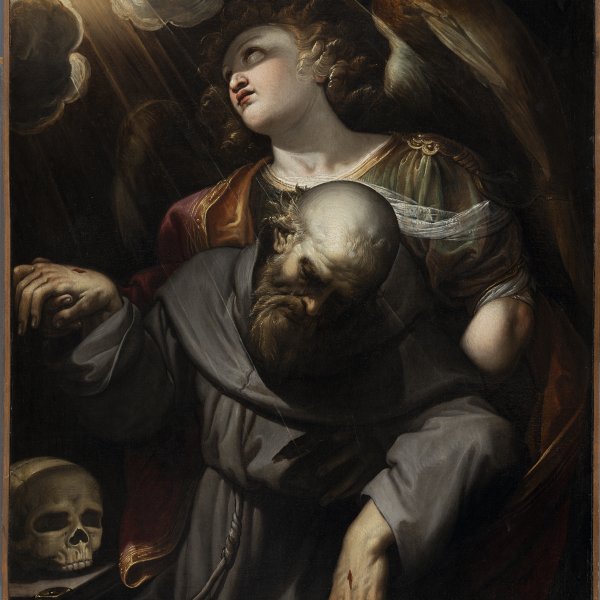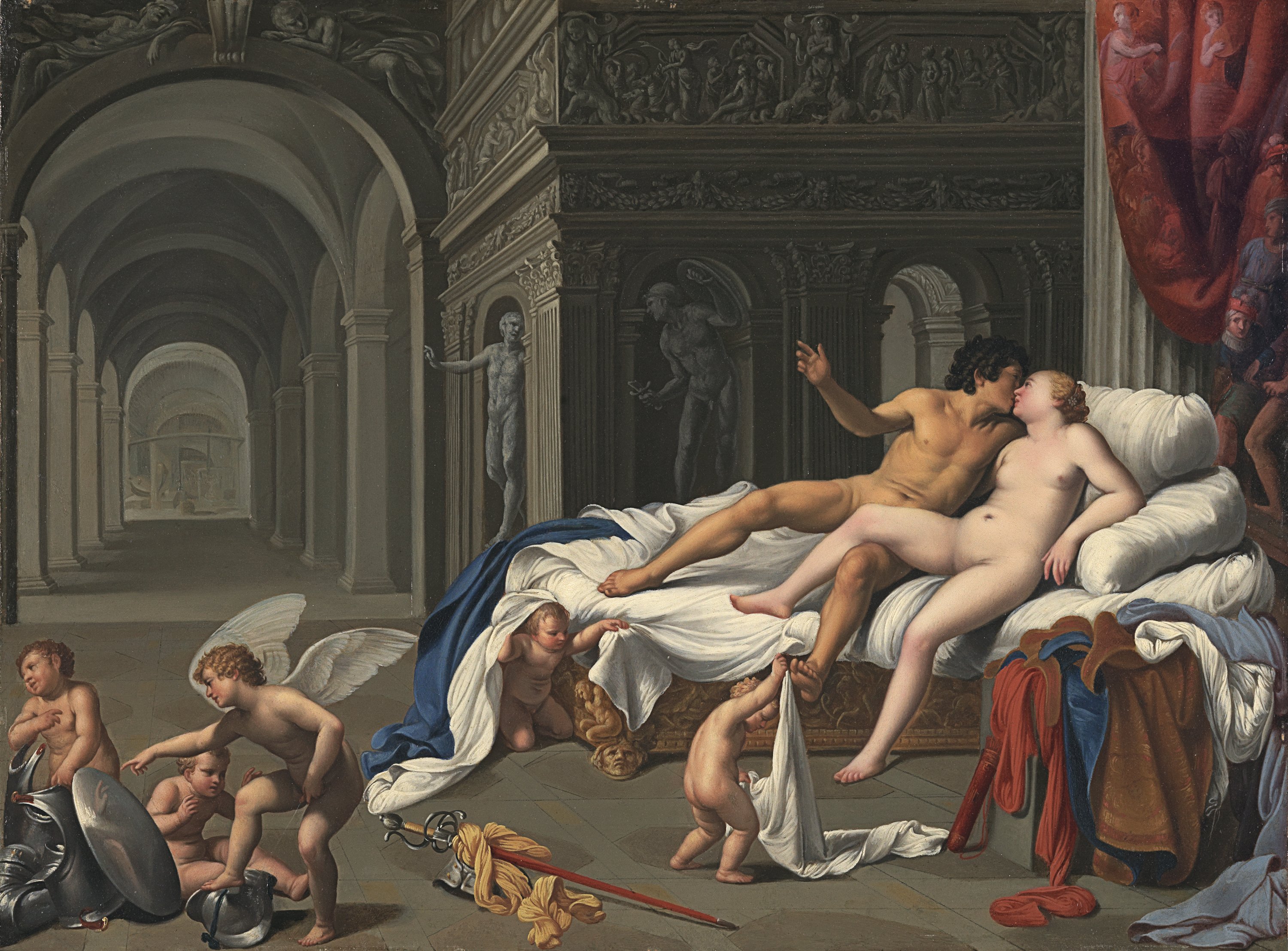Venus and Mars
ca. 1600
Oil on copper.
39.5 x 55 cm
Carmen Thyssen Collection
Inv. no. (
CTB.1982.32
)
Room A
Level 0
Carmen Thyssen Collection and Temporary exhibition rooms
This picture illustrates the clandestine love of Venus, wife of Vulcan, and Mars, and is taken from Ovid's Metamorphoses (IV, 167-189). Within the immense and complex residence of Vulcan, whose forge appears at the end of the colonnade of the loggia, the two lovers surrender to their passion on the dazzling counterpane in the company of five putti, two of whom amuse themselves with the bedding, while the remaining trio play with the god of war's armour-a clearly humorous, anti-classical touch. The compositional stratagems adopted for the little building shown behind the bed, the highly decorated bas-reliefs and the gesturing statues in the niches (which one sees again in the Presentation of the Virgin in Santa Maria in Acquiro in Rome), and the red drapery on the columns, painted with such movement as to make the fabric almost anthropomorphic, are all delightful exercises in painterly illusionism.
The Venetian Carlo Saraceni is mentioned by the Sienese doctor and historian Giulio Mancini as among those who first adopted Caravaggio's naturalistic language (albeit with the limiting expression 'in part'). Mancini's statement should not surprise us, but it is obvious that any sympathy for Caravaggio (which is, indeed, undeniable, though not so marked in Saraceni as to warrant his inclusion among his most enthusiastic supporters) cannot have occurred much before 1606, the year in which Saraceni signed his Rest on the Flight into Egypt at the Camaldolese Hermitage in Frascati.
The refined picture in the Carmen Thyssen-Bornemisza Collection belongs instead to the pre-naturalistic phase of the Venetian painter whose short career still includes too many interpretative uncertainties, particularly concerning the issue of his formative years. If we are to trust his biographer, Giovanni Baglione, Saraceni reached Rome in the last years of the 16th century where he was admitted into the workshop of the Vicenzan sculptor Camillo Mariani. It is difficult to hazard any guesses as what specific influence Mariani may have had on Saraceni. Modern criticism has opted to see "Carlo Veneziano's" early training as essentially with the 16th century mould (Bassano, Romanino, Savoldo) with additional Roman elements derived from the Cavaliere d'Arpino, as well as from the new Emilian classicism and from the "focus on the natural motif, applied with extreme lucidity by Elsheimer". In the midst of this complex and intriguing mixture of influences it is clear that the Thyssen-Bornemisza Venus and Mars departs from the early international Mannerism (albeit without repudiating it completely) to adopt the neo-Raphaelesque, classicist viewpoint of the followers of the Carracci. Although the copper support contributes to the emphasis on the unblemished surface and the roundness of the lovers' limbs, of the putti, and the various furnishings and in particular Mars's shield and helmet, it is still the case that this crude optical objectivity derives from Saraceni's sympathy for Domenichino and, perhaps even more so, for Albani whose somatic typology is so notably evident in the five putti. It is emblematic that the clean profile against the white background of the wing and the flat gold and chestnut curls of the largest putto (the only one with wings) who is looking at his reflection in the mirror as he irreverently waters the helmet, is practically a pure imitation of Albani.
This figure in fact marks the starting point for the moderate enthusiasm for Caravaggio and the classicising elegance shown two decades later by a Veronese sympathiser of Saraceni's, Alessandro Turchi (for example, his adolescent angel in The Flight into Egypt in the Prado). It was in fact on Veronese artists in Rome that this early work of Saraceni's exercised its greatest influence. Ottani Cavina aptly dates it to the beginning of the 17th century, just later than or concurrent with its close kin, the Bathing Venus and Mars in Sir Anthony Clark's Collection in Minneapolis, while Waddingham thinks it belongs to the beginning of the second decade). Bassetti, for instance, in a composition of the Chastity of Joseph offered an analogous array of niches and moving statues in a loggia in the background. Again, Saraceni repeated his extravagant trompe-l'oeil drapery in the frescoes of the Sala Regia in the Quirinale Palace, a testing ground for his Veronese followers.
Roberto Contini
The Venetian Carlo Saraceni is mentioned by the Sienese doctor and historian Giulio Mancini as among those who first adopted Caravaggio's naturalistic language (albeit with the limiting expression 'in part'). Mancini's statement should not surprise us, but it is obvious that any sympathy for Caravaggio (which is, indeed, undeniable, though not so marked in Saraceni as to warrant his inclusion among his most enthusiastic supporters) cannot have occurred much before 1606, the year in which Saraceni signed his Rest on the Flight into Egypt at the Camaldolese Hermitage in Frascati.
The refined picture in the Carmen Thyssen-Bornemisza Collection belongs instead to the pre-naturalistic phase of the Venetian painter whose short career still includes too many interpretative uncertainties, particularly concerning the issue of his formative years. If we are to trust his biographer, Giovanni Baglione, Saraceni reached Rome in the last years of the 16th century where he was admitted into the workshop of the Vicenzan sculptor Camillo Mariani. It is difficult to hazard any guesses as what specific influence Mariani may have had on Saraceni. Modern criticism has opted to see "Carlo Veneziano's" early training as essentially with the 16th century mould (Bassano, Romanino, Savoldo) with additional Roman elements derived from the Cavaliere d'Arpino, as well as from the new Emilian classicism and from the "focus on the natural motif, applied with extreme lucidity by Elsheimer". In the midst of this complex and intriguing mixture of influences it is clear that the Thyssen-Bornemisza Venus and Mars departs from the early international Mannerism (albeit without repudiating it completely) to adopt the neo-Raphaelesque, classicist viewpoint of the followers of the Carracci. Although the copper support contributes to the emphasis on the unblemished surface and the roundness of the lovers' limbs, of the putti, and the various furnishings and in particular Mars's shield and helmet, it is still the case that this crude optical objectivity derives from Saraceni's sympathy for Domenichino and, perhaps even more so, for Albani whose somatic typology is so notably evident in the five putti. It is emblematic that the clean profile against the white background of the wing and the flat gold and chestnut curls of the largest putto (the only one with wings) who is looking at his reflection in the mirror as he irreverently waters the helmet, is practically a pure imitation of Albani.
This figure in fact marks the starting point for the moderate enthusiasm for Caravaggio and the classicising elegance shown two decades later by a Veronese sympathiser of Saraceni's, Alessandro Turchi (for example, his adolescent angel in The Flight into Egypt in the Prado). It was in fact on Veronese artists in Rome that this early work of Saraceni's exercised its greatest influence. Ottani Cavina aptly dates it to the beginning of the 17th century, just later than or concurrent with its close kin, the Bathing Venus and Mars in Sir Anthony Clark's Collection in Minneapolis, while Waddingham thinks it belongs to the beginning of the second decade). Bassetti, for instance, in a composition of the Chastity of Joseph offered an analogous array of niches and moving statues in a loggia in the background. Again, Saraceni repeated his extravagant trompe-l'oeil drapery in the frescoes of the Sala Regia in the Quirinale Palace, a testing ground for his Veronese followers.
Roberto Contini










